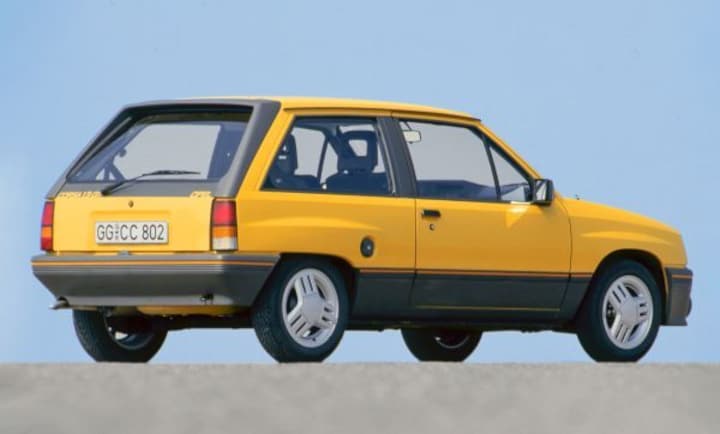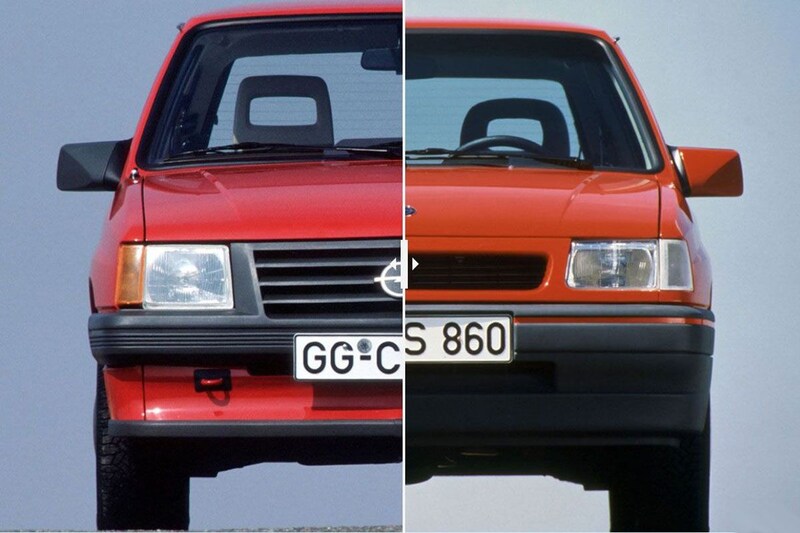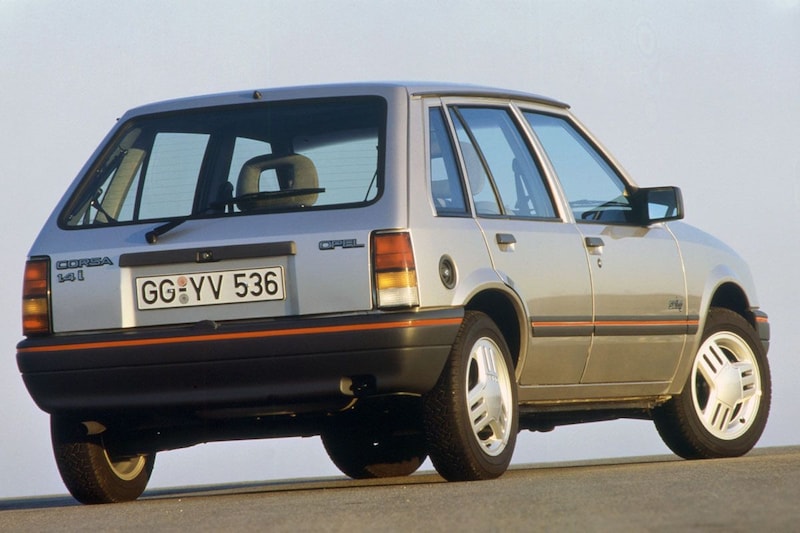If Spider and Irmscher Sprint had come…


This year we regularly look back to the beautiful car year 1982. The Opel Corsa is one of the striking newcomers that provided a breath of fresh air in the automotive world forty years ago. It was Opel’s first small car, under the Kadett. Here’s why the car impressed even more in 1982.
What did the start-up trajectory of the Opel Corsa look like?
At the end of the 1970s, the car market looked very prosperous for Opel. In particular, the new Opel Kadett D pushed production numbers to astronomical heights. With its front-wheel drive and square looks, it made it to the top of the sales lists in the Netherlands and, just like its predecessor, proved to be unprecedentedly popular. Action was needed, however, because just below the C-segment of the Kadett, the pie in the B-segment has meanwhile been divided by competitors such as Ford and Volkswagen, which, in the form of the Fiesta and Polo respectively, had been on the market since the mid-1970s. were the market. Opel therefore missed out on customers who, in search of something smaller and cheaper, were forced to knock on the door of the competition. In 1982 the time had finally come: the arrival of Opel’s own B-segment was announced with the Corsa Spider Concept at the Geneva motor show. The production version followed shortly after. Unfortunately for the fans, not as Spider, but as an extremely responsible three-door hatchback and two-door sedan.

The Opel Corsa debuted as a Spider concept car in March 1982.

Design sketches of the Opel Corsa, the TR was also included in the design from the start.
How revolutionary was he?
The compact three-door hatchback with front-wheel drive and a transverse four-cylinder was by no means a novelty in 1982, but the arrival of a B-segment car was certainly revolutionary for Opel: Opel customers have traditionally been very loyal to the brand and an introduction can therefore be only do it right once. In any case, there was little to fault in the design: Opel designer Erhard Schnell had started with sharp, straight lines, which were supplemented on the flanks with beautiful, bulging wheel arches for the sporty note. The Corsa was received almost unanimously as a freshly designed compact car. In addition, the Corsa was the first Opel in which air resistance already played an important role in the design: with a Cw value of 0.36 it was one of the smoothest in its class, good for an economical character. With the E-Kadett and the Omega, Opel would then take even greater steps in reducing air resistance.

The Opel Corsa had a transversely placed four-cylinder and front-wheel drive, so not revolutionary and the Kadett D also had a similar construction.
What were the choices at the market launch?
The Opel Corsa initially offered a choice of two body styles: a three-door hatchback and a two-door sedan called TR. That sedan was mainly developed to give the original customers of the C-Kadett the option to purchase a sedan again, because such a variant was no longer available with the D-Kadett. Incidentally, Opel preferred to speak of a ‘notchback version’. The first Corsas were delivered in the early years with a transversely mounted 1.0, 1.2 or 1.3 liter four-cylinder, good for successively 45, 55 and 70 hp. The latter was only available in the SR, the sportiest of the Corsas until the arrival of the GSi in 1988. Incidentally, Opel already spoke in the brochure about ‘stunning performance’, indicating a top speed of no less than 166 km/h. The least powerful 1.0 stiefelde also cheerfully to 140 km/h, so it was not very much. All variants with the 1.3-litre engine were supplied as standard with a five-speed gearbox, the less powerful versions had four gears. In 1985, the five-door and four-door variants were added to the range, which immediately made the Corsa a lot more interesting for family transport.

A lavishly decorated Luxus, which was in our price list as a Luxury.
How many were built and…
…how many are left?
From 1983 to 1993, a total of 3,105,430 Opel Corsa A were built, of which 120,754 were sold in our country. Of that number there are still 1,301 left in various variants, which are divided over the years of construction as follows:
1983 101
1984 183
1985 140
1986 175
1987 110
1988 132
1989 101
1990 79
1991 146
1992 134
Total 1,301

Production started in August 1982.
How was the Corsa received?
It was fresh, new and apparently an excellent choice, because the Opel Corsa proved to be at least as successful in its segment as the Kadett. To give you an idea: a year after the introduction, Opel sold a small 13,000 Corsas in the Netherlands. That even grew to more than 18,000 in 1984, a quarter of Opel’s total sales. For comparison: in the same year Volkswagen sold about 3,500 Polos and in 2021 a total of just over 15,000 Opels were sold. Other times …
source: cartalk international
What were his competitors?
In 1982 you paid fl. 15,068 (€6,849) for the entry-level Corsa. For that amount you went home with the Corsa 1.0 S. If you had enough budget for the 1.3 S SR, you tapped fl. 19,508 (€9,754) at the Opel dealer. In comparison: cheaper driving was certainly possible, but then you had to look to the Eastern Bloc. With the 1200 S, Lada had a true price package; this model only cost fl. 9,999 (€4,536), while the Skoda 120 LS was admittedly slightly more modern, but with fl. 12,375 (€5,625) also considerably more expensive. The real competitors were mainly found at Ford and Volkswagen, where the Fiesta with a starting price of fl. 15,611 (€7,096) was slightly more expensive and the Polo was almost out of the market with over 19 grand (€8,674). . If you wanted something more frivolous, you could go to Renault for the now second generation of the 5, which has been available since 1984 for just under 16 grand (€7,258). And then we haven’t even included the Fiat Uno, the Peugeot 205 and white ravens like the Yugo 45/55, Lancia Ypsilon and Austin Metro. So busy everywhere, in the segment of the Corsa. That makes it even more impressive that the sale of the newcomer went so smoothly.
How was it received by consumers?
Good, that’s the answer. The model lasted no less than eleven years, underwent two facelifts and the counter only stopped in 1993 when more than 120,000 Corsas were sold in the Netherlands. In 1984, the Corsa’s peak year, it became the first B-segment car to reach fifth place in the list of best-selling cars. The Peugeot 205, the next competitor in the list, did not go further than eighth place and sold just over half the number of Corsas that year. The 205 passed him a few years later, but the Corsa actually continued to do well throughout its entire term. The main reason: great price and no fuss for the traditional Dutch Opel drivers, of which there were still many at the time, and a design that remained fresh for a long time.
Any details during his life?
Over the course of its long career, the Opel Corsa A went through a number of life stages, in which the 1.2-litre engine remained the constant factor: even after the last facelift in 1990, it, now equipped with injection, remained until the very end. available. The 1.0-litre unfortunately had to disappear from the scene that same year and the 1.3-litre was replaced by a 1.4-litre injection engine. The 1.5-litre diesel block, which was borrowed from the shelves of Isuzu, appeared on the scene in 1987 and was known for its extremely frugal character, whereby the amount of horsepower available can also be called economical: only 50 units were available to the Corsa. . That is why the 1.5 turbo diesel was launched a year later, which made it to a somewhat more pleasant 67 hp. Incidentally, both diesel engines were discontinued after 1990.

Finally: a really fast one
In a market where even the small segment could not escape the popularity of the hot hatchback, it was high time for Opel to get involved in the violence. That meant a GSi nameplate on the rear and a 1.6-litre injection engine under the hood, good for 101 hp, acceleration from 0 to 100 km/h in an acceptable 9.5 seconds and a top speed of 188 km/h . Nevertheless, the GSi was a bit behind the times with these figures in its segment: Peugeot set the tone by developing the fast GTI in 1984, which was good for 105 (later 115) hp, and in 1987 even with the 130 hp GTI 1.9 to appear.

The Opel Corsa did not appear as a GSi until late.
Which version appeals most to the imagination?
An early 1.3 SR for sheer driving pleasure, a GSi that gives it a little extra performance, a slow turboless diesel that takes you to the other side of the country with a teaspoon of fuel: each Corsa has its own charms. Yet one remained unnamed: the prototype Corsa Spider Concept. Many people did not like the fact that Opel decided not to build it. But then there was Bernd Michalak. This German car designer decided to convert existing three-door Corsas into a speedster variant, which looked very much like the Opel prototype itself. It was not cheap: you could order a Michalak Corsa Spider for a small 24 mille in Deutsche Mark, or about €12,000 in the current currency. Ultimately, 98 were built, of which about 25 are now left. The model, like the prototype, was a pure two-seater. Under the ‘spider’ hood was a two-piece hardtop, with which you could transform the convertible into a covered two-seater. Only for when it was really necessary, because as beautiful as the Corsa Spider was, closed the car was an abomination to see. Curious about such a Michalak Corsa Spider? On autoweek.nl you will find a Blits Property from 2014 in which TV chef Danny Jansen presents his extremely rare Corsa to AutoWeek.
It could have been so much fun
That it all could have been very different, was already clear in 1983. Shortly after the launch, home tuner Irmscher came up with the Corsa Sprint. It was the intention of this prototype to build about 200 units as a homologation special for a possible rally Corsa to be built. This little bomb was presented at the 1983 Frankfurt Motor Show, including roll bar, beautiful wide wheel arches with open rears, stripped interior, special Bilstein gas dampers, a lowered chassis, an 80 liter fuel tank, reinforced springs and a special lightweight instrument cluster. The best part, however, was under the hood: a horny 1.3-litre twin-carbureted four-cylinder engine, producing 126 hp at 7,600 rpm. With a weight of less than 750 kilos, it is almost guaranteed to be a fun package. However, it has remained with this prototype.

An Opel Corsa with 126 hp, Irmscher would have loved to build it.

But with Irmscher tuning you could also make your Corsa look nice and thick without much power.
What has been the impact of the Opel Corsa?
To state now that the arrival of the Opel Corsa has led to an effect of historic proportions on the car market is a bit too much honor. Opel, and especially the Opel of the 1980s, prided itself on building excellent cars for a pleasant price tag, under the motto ‘just act normal, that’s crazy enough’. An excellent choice given the success on the car market. That is no different with the Corsa. What this car did do is make a significant contribution to Opel’s skyrocketing sales figures at the time. Of course, the Kadett was the absolute top of the range, but from scratch Opel managed to conquer a huge piece of the pie within the B segment with the Corsa A. The brand achieved a mega result. Seen in this way, the Corsa was indeed a revolutionary car, which owes its success mainly to the fact that it is remarkably inconspicuous. And they can be proud of that at Opel.
.
– Thanks for information from Autoweek.nl










